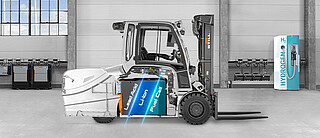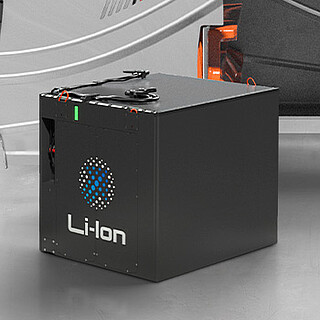What's the best drive solution for your business?

Looking to upgrade your forklift fleet or order a new industrial truck? Then you'll find yourself spoilt for choice when it comes to selecting a drive unit. But sometimes more choice means more confusion. Should you opt for a lead-acid battery or a lithium-ion one? And what about the fuel cell option? Time to take stock and get some answers.
Energy is precious. And when deciding on the best energy solution for your forklift, there are lots of factors to consider. There are economic and financial considerations, of course. But also the questions of infrastructure and future-proofing. For instance, Europe is aiming to go climate-neutral by 2050: What impact will that have on investment in drive technologies? And what will happen to electricity prices? According to a study released in May by Swiss consultancy Prognos, electricity prices are expected to increase by around 50% by 2030. Moreover, customers are increasingly demanding that companies improve their green credentials. In today's market, a strong track record on sustainability issues can give you a real competitive edge. So you see, there's plenty to think about before making an investment. To make matters worse, this decision is made even harder by some suppliers and manufacturers coming down loudly on one side of the argument – often where it suits their own interests. In this blog post, we therefore want to take an open and honest look at all the different options. After all, with so many different factors to consider, the answer is anything but simple.
Lead-acid batteries: Is there life in this old technology yet?
In many ways, lead-acid batteries are becoming pretty outdated. These old faithfuls have been around in industry since the end of the 19th century. But now "the technology has reached the end of the road," says Dyrk Draenkow, Product Manager at STILL. No one is going to be developing lead-acid technology in future, e.g. creating batteries with much shorter charge times or much higher energy density. And they're not exactly a sustainable option. Many of the materials used to produce them are both damaging to the environment and challenging to recycle – although, as Dyrk Draenkow is quick to point out, "we can now recycle more than 90% of these," which is one advantage of this technology having been around for so long.

In reality, it's probably too soon to write lead-acid batteries off completely. Why? Because they remain the best fit for some requirements. As Björn Grünke, Energy Systems Product Manager and Battery Specialist at STILL, explains: "Lead-acid batteries are still by far the best choice when it comes to investment costs." They're extremely cheap, costing just EUR 150 per kilowatt-hour. But here again, it's worth taking a closer look at the numbers as, depending on how the batteries are used, there can be hidden costs. For instance, partial charging is not an option with lead-acid batteries, so operators must build long breaks and battery changes into their schedules. This wastes time, increases the risk of accidents and, depending on the shift model, can mean that trucks aren't always available when they're needed. For some companies, the cost of these limitations on their productivity soon adds up.
"If all the trucks need to be charged simultaneously at the end of the shift, this can really bump up a company's electricity costs," explains Björn Grünke. That’s because energy suppliers still calculate their tariffs based on peak usage. "Even if your peak electricity usage is a one-off annual event, you still pay the higher tariff." Overall, lead-acid batteries are best suited to operators with just a few trucks operating for a limited time. These operators can take advantage of the cheaper price without being impacted by the lack of flexibility.
Lithium-ion batteries: What's the truth behind all the prejudice?
When looking into lithium-ion batteries, you still come across an astonishing amount of prejudice and half-truths – even in the intralogistics sector where Li-ion batteries have been well established for a relatively long time. The public debate around electric cars can be misleading, since most of the downsides you hear about don't actually apply to the intralogistics sector. The lack of an adequate charging network is certainly a huge issue for electric cars, but is completely irrelevant when you have a charging point for your electric forklifts in every corner of your warehouse. In fact, flexible charging is one of the major plus points of lithium-ion batteries, especially for businesses where trucks are used in multi-shift operations.

"Li-ion batteries can have a top-up charge at any time, they don't need changing and they deliver consistently high performance," explains Dyrk Draenkow. "Unlike with lead-acid batteries, there's no dip in performance when the charge drops to below a third." You also need much less infrastructure – gone are the battery changing stations, water tanks and extraction units needed for lead-acid batteries. Another major benefit of Li-ion batteries is their energy efficiency, although it's important to remember that short periods of rapid charging use large amounts of energy, which can lead to higher peak demand. "If you're clever, you can avoid this though," says Björn Grünke. He and his team have lots of experience advising companies on how best to manage their charging schedule and avoid these big spikes in demand. "Charging management is key. It's all about spreading your battery charging out over time." Björn Grünke is also confident that this will get even easier in the future as we see improvements in networking and inductive charging technologies.
Where lithium-ion batteries score less highly is on their price, which is currently two to three times higher than for lead-acid batteries. But as Björn Grünke reminds us, "Li-ion batteries last twice as long, if not more." Looking at the way prices have evolved since 2010, he is also confident that the cost of investing in this technology will continue to fall. Another major downside of Li-ion batteries is the lack of recycling options – an area where the technology has not advanced particularly far. Li-ion batteries are also sensitive to very low (below 5°C) or very high (above 35°C) temperatures, which can pose a problem in certain specialist operating environments. Nonetheless, overall the positives outweigh the negatives. Lithium-ion batteries offer a very flexible drive solution. It's well worth taking a look to see if you can save time and money by taking advantage of the simpler, more flexible charging.
Fuel cells: Future vision or current reality?
The idea of generating energy from hydrogen may seem like the stuff of science fiction, but fuel cell technology is already more advanced than you might think. Once again, it's important not to get distracted by similar discussions in the automotive sector. "This technology is ready to go, right now," explains Dyrk Draenkow. The brilliance of this technology is that you don't have to plug the truck in to charge it up; the fuel cell converts the chemical energy in the hydrogen directly into electrical energy. There are already more than 40,000 fuel cell forklifts in operation in the US, albeit primarily at companies that use or produce hydrogen as part of their production process. Here in Europe, we're still a little way behind, with just 500 fuel cell trucks currently in operation. "And even as a fan of this technology, I have to concede that all of these were government backed projects," admits Dyrk Draenkow.

There is, however, genuine interest in fuel cell technology – and for good reason. Fuel cells take up less space and do away with the need for battery changes and chargers. Moreover, fuel cells can be fully refuelled at hydrogen dispensers in two to three minutes, just like filling up at a traditional petrol station. In short, it's a fast, efficient and effective drive solution. Plus, as Dyrk Draenkow points out, "you no longer have to worry about managing peaks in demand." By investing in a fuel cell, you are essentially investing in the future – with all its advantages and disadvantages. "Forecasts suggest that hydrogen fuel usage will increase significantly in Germany from 2030 onwards," explains Dyrk Draenkow. If this happens, prices will likely fall, the infrastructure will improve and investment in this technology will see a real boost. "The problem is that these are only predictions, and whether they prove correct depends on the decisions made by policy-makers."
That said, some exciting developments are already under way. The possibility of using fuel cells in shipping, aviation and heavy goods vehicles is currently the subject of much research, since partial charging of Li-ion batteries is simply not a viable option in situations where heavy loads need to be transported over long periods. There are already ocean-going ferries powered by fuel cells and tests have begun on the first cruise ships with this technology. Innovations from these different sectors can all feed into one another and fuel cells have the potential to provide a real answer to the question of sustainability. There's just one condition, as Dyrk Draenkow points out: "If net-zero is our aim, then the hydrogen itself must be generated from renewable sources."
Conclusion: What's the right drive solution for you?
If you approach this question with an open mind, without any preconceived ideas about the different technologies, then it's clear that the answer depends on your specific use case and operating environment. To find the right solution, you need to carefully consider all the alternatives – don’t just rule out lead-acid batteries as outdated and fuel cells (for which the technology is very much available!) as too futuristic. After all, finding the right drive solution for your forklift fleet can save you time, increase your flexibility and cut costs in all sorts of ways – sometimes all at the same time.
PS: If you want to find out more, our STILL experts Dyrk Draenkow and Björn Grünke recently ran a webinar on this very subject, in which they talked in a lot more detail about many of the ideas discussed in this blog post. You'll find a recording of the webinar here.
Contact request
Subscribe to the Newsletter !
Always up to date with STILL: Subscribe to the STILL newsletter and we will inform you regularly about interesting industry topics.
